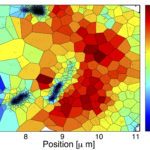Link to Pubmed [PMID] – 25353527
Phys Rev E Stat Nonlin Soft Matter Phys 2014 Feb;89(2):022726
How does one optimally determine the diffusion coefficient of a diffusing particle from a single-time-lapse recorded trajectory of the particle? We answer this question with an explicit, unbiased, and practically optimal covariance-based estimator (CVE). This estimator is regression-free and is far superior to commonly used methods based on measured mean squared displacements. In experimentally relevant parameter ranges, it also outperforms the analytically intractable and computationally more demanding maximum likelihood estimator (MLE). For the case of diffusion on a flexible and fluctuating substrate, the CVE is biased by substrate motion. However, given some long time series and a substrate under some tension, an extended MLE can separate particle diffusion on the substrate from substrate motion in the laboratory frame. This provides benchmarks that allow removal of bias caused by substrate fluctuations in CVE. The resulting unbiased CVE is optimal also for short time series on a fluctuating substrate. We have applied our estimators to human 8-oxoguanine DNA glycolase proteins diffusing on flow-stretched DNA, a fluctuating substrate, and found that diffusion coefficients are severely overestimated if substrate fluctuations are not accounted for.

